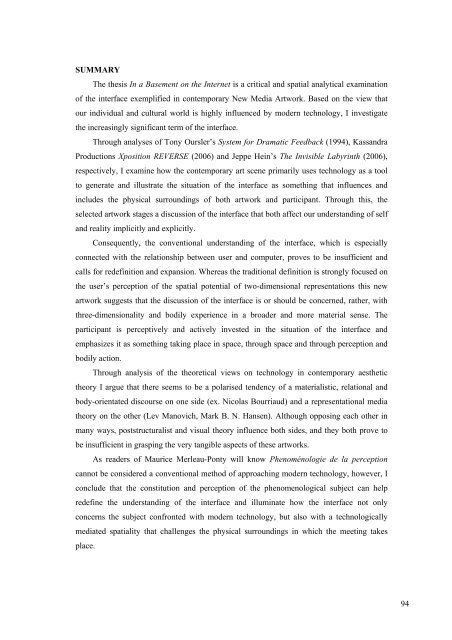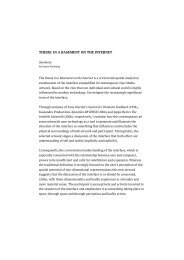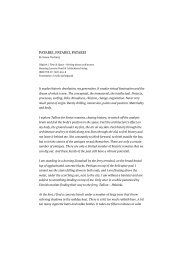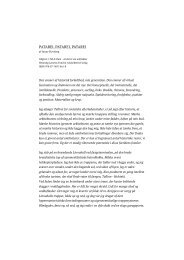Speciale_publiceret
You also want an ePaper? Increase the reach of your titles
YUMPU automatically turns print PDFs into web optimized ePapers that Google loves.
SUMMARY<br />
The thesis In a Basement on the Internet is a critical and spatial analytical examination<br />
of the interface exemplified in contemporary New Media Artwork. Based on the view that<br />
our individual and cultural world is highly influenced by modern technology, I investigate<br />
the increasingly significant term of the interface.<br />
Through analyses of Tony Oursler’s System for Dramatic Feedback (1994), Kassandra<br />
Productions Xposition REVERSE (2006) and Jeppe Hein’s The Invisible Labyrinth (2006),<br />
respectively, I examine how the contemporary art scene primarily uses technology as a tool<br />
to generate and illustrate the situation of the interface as something that influences and<br />
includes the physical surroundings of both artwork and participant. Through this, the<br />
selected artwork stages a discussion of the interface that both affect our understanding of self<br />
and reality implicitly and explicitly.<br />
Consequently, the conventional understanding of the interface, which is especially<br />
connected with the relationship between user and computer, proves to be insufficient and<br />
calls for redefinition and expansion. Whereas the traditional definition is strongly focused on<br />
the user’s perception of the spatial potential of two-dimensional representations this new<br />
artwork suggests that the discussion of the interface is or should be concerned, rather, with<br />
three-dimensionality and bodily experience in a broader and more material sense. The<br />
participant is perceptively and actively invested in the situation of the interface and<br />
emphasizes it as something taking place in space, through space and through perception and<br />
bodily action.<br />
Through analysis of the theoretical views on technology in contemporary aesthetic<br />
theory I argue that there seems to be a polarised tendency of a materialistic, relational and<br />
body-orientated discourse on one side (ex. Nicolas Bourriaud) and a representational media<br />
theory on the other (Lev Manovich, Mark B. N. Hansen). Although opposing each other in<br />
many ways, poststructuralist and visual theory influence both sides, and they both prove to<br />
be insufficient in grasping the very tangible aspects of these artworks.<br />
As readers of Maurice Merleau-Ponty will know Phenoménologie de la perception<br />
cannot be considered a conventional method of approaching modern technology, however, I<br />
conclude that the constitution and perception of the phenomenological subject can help<br />
redefine the understanding of the interface and illuminate how the interface not only<br />
concerns the subject confronted with modern technology, but also with a technologically<br />
mediated spatiality that challenges the physical surroundings in which the meeting takes<br />
place.<br />
94






